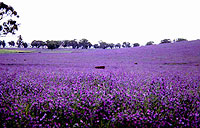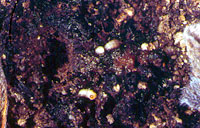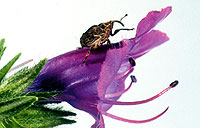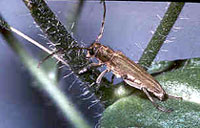| Entomology Home |

an overview
of biological control research in CSIRO Entomology
| Biological Control Home | ||
|
|
||
| Aquatic Weeds » | ||
|
|
||
|
|
||
| Biopesticides | ||
| Entomology Home | ||
| Biological Control Home > Classical biocontrol > Agricultural weeds |
Paterson's curse, Echium plantagineum
|
 |
 |
 |
Paterson's curse,
introduced to Australia from Europe during the mid-nineteenth century,
is Australia's worst broadleaf temperate pasture weed. Its high
seed production (thousands of seeds per square metre), seed longevity
of more than seven years and an ability to germinate at any time
of year, given the right conditions, contribute to making it such
a persistent weed.
Biological control of Paterson's curse started in earnest in the
late 1980s after a court battle involving bee keepers and six agents
have now been released. The first, a leaf-mining moth Dialectica
scalariella, is widely distributed but has little impact. Of
the remaining six, four are currently being actively redistributed
across southern Australia.
The crown weevil (Mogulones larvatus) is the most damaging agent, often killing the weed outright on a large scale, at a number of sites in NSW, Victoria and South Australia.
The root weevil (Mogulones geographicus), the flea beetle (Longitarsus echii), the flower beetle (Meligethes planiusculus), and the stem-boring beetle, (Phytoecia coerulescens) are also established in all southern mainland states, the most promising of which are the focus of a nationwide redistribution program.
Supported by: Australian Wool Innovation, Meat and Livestock Australia
 |
